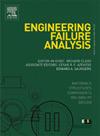Wear and abnormal fracture failure mechanisms of alloy teeth in TBM insert tooth disc cutters
IF 4.4
2区 工程技术
Q1 ENGINEERING, MECHANICAL
引用次数: 0
Abstract
Insert tooth disc cutters are among the commonly used cutters in TBMs (Tunnel Boring Machines). However, due to the sharpness, protrusion, and small contact area between the alloy teeth and rock, these cutters are prone to uneven loading and stress concentration. This makes the alloy teeth susceptible to abnormal failure modes such as chipping, breakage, and detachment during operation. To improve the compatibility of insert tooth disc cutters with rock, this study investigates the wear and failure mechanisms of these cutters. In an analysis of failed disc cutters, it was found that 53% of the alloy teeth had failed, with breakage and chipping accounting for the highest proportions, at 37% and 15%, respectively. The study proceeded by characterizing the microscopic wear morphology of both the cutter ring matrix and the alloy teeth. The results revealed that the wear of alloy teeth is characterized by shallow surface scratches and pits caused by abrasive, adhesive, and fatigue wear. In contrast, the matrix of the cutter ring exhibited plowing grooves formed primarily by abrasive and adhesive wear. Furthermore, a finite element model (FEM) of the rock-breaking process was established and validated against experimental data to analyze the stress distribution and surface contact pressure of the alloy teeth during rock cutting. Simulation results indicated significant impact phenomena as the alloy teeth penetrate the rock, which reduces their service life. Both spherical and wedge-shaped teeth exhibited noticeable stress concentration and uneven loading, with the regions of stress concentration closely aligning with the areas where chipping occurred. This correlation confirms that the primary causes of tooth chipping are stress concentration and uneven loading. This research provides valuable insights for the selection and optimized design of insert tooth disc cutters in TBM applications.
掘进机插入式齿盘铣刀合金齿的磨损和异常断裂失效机制
插入式齿盘铣刀是隧道掘进机(TBM)中常用的铣刀之一。然而,由于合金齿锋利、突出、与岩石接触面积小,这些铣挖机很容易受到不均匀载荷和应力集中的影响。这就使得合金齿在操作过程中容易出现崩裂、断裂和脱落等异常失效模式。为了提高插入式齿盘铣刀与岩石的兼容性,本研究调查了这些铣刀的磨损和失效机理。在对失效圆盘铣挖机的分析中发现,53% 的合金齿失效,其中断裂和崩裂所占比例最高,分别为 37% 和 15%。研究接着分析了切刀环基体和合金齿的微观磨损形态特征。结果显示,合金齿的磨损特征是由磨料磨损、粘着磨损和疲劳磨损造成的浅表划痕和凹坑。相比之下,刀环的基体则呈现出主要由磨料磨损和粘着磨损形成的沟槽。此外,还建立了岩石破碎过程的有限元模型(FEM),并根据实验数据进行了验证,以分析合金齿在岩石切割过程中的应力分布和表面接触压力。模拟结果表明,合金齿在穿透岩石时会产生明显的冲击现象,从而降低其使用寿命。球形和楔形齿都表现出明显的应力集中和不均匀加载,应力集中区域与发生崩裂的区域紧密相连。这种相关性证实,造成崩齿的主要原因是应力集中和载荷不均。这项研究为在掘进机应用中选择和优化设计插入式齿盘铣刀提供了有价值的见解。
本文章由计算机程序翻译,如有差异,请以英文原文为准。
求助全文
约1分钟内获得全文
求助全文
来源期刊

Engineering Failure Analysis
工程技术-材料科学:表征与测试
CiteScore
7.70
自引率
20.00%
发文量
956
审稿时长
47 days
期刊介绍:
Engineering Failure Analysis publishes research papers describing the analysis of engineering failures and related studies.
Papers relating to the structure, properties and behaviour of engineering materials are encouraged, particularly those which also involve the detailed application of materials parameters to problems in engineering structures, components and design. In addition to the area of materials engineering, the interacting fields of mechanical, manufacturing, aeronautical, civil, chemical, corrosion and design engineering are considered relevant. Activity should be directed at analysing engineering failures and carrying out research to help reduce the incidences of failures and to extend the operating horizons of engineering materials.
Emphasis is placed on the mechanical properties of materials and their behaviour when influenced by structure, process and environment. Metallic, polymeric, ceramic and natural materials are all included and the application of these materials to real engineering situations should be emphasised. The use of a case-study based approach is also encouraged.
Engineering Failure Analysis provides essential reference material and critical feedback into the design process thereby contributing to the prevention of engineering failures in the future. All submissions will be subject to peer review from leading experts in the field.
 求助内容:
求助内容: 应助结果提醒方式:
应助结果提醒方式:


